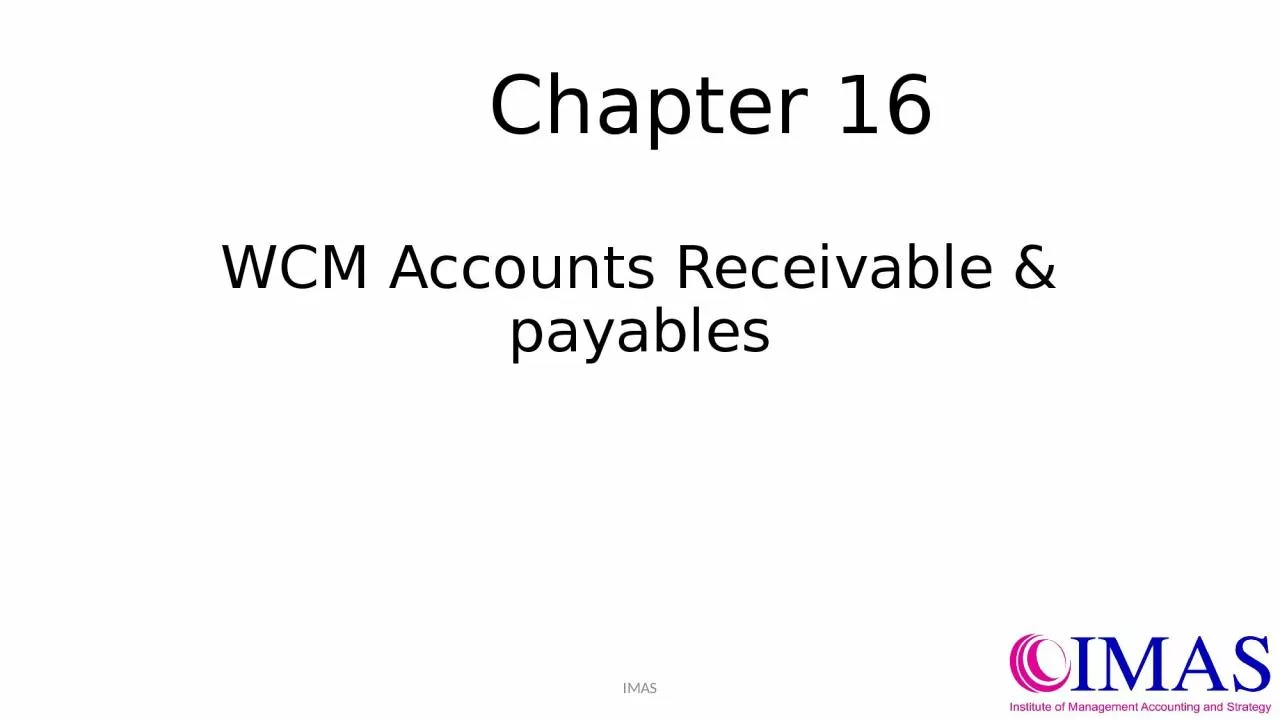

IMAS 1 Working Capital management of Receivables Why do companies grant credit Cost associated with granting credit IMAS 2 Objective The objective of receivables management is to make sound decisions as regard to investment in debtors ID: 1027252
Download Presentation The PPT/PDF document "Chapter 16 WCM Accounts Receivable &..." is the property of its rightful owner. Permission is granted to download and print the materials on this web site for personal, non-commercial use only, and to display it on your personal computer provided you do not modify the materials and that you retain all copyright notices contained in the materials. By downloading content from our website, you accept the terms of this agreement.
1. Chapter 16WCM Accounts Receivable & payablesIMAS1
2. Working Capital management of ReceivablesWhy do companies grant credit?Cost associated with granting creditIMAS2
3. Objective The objective of receivables management is to make sound decisions as regard to investment in debtors.promote sales and profits until that point is reached where the return on investment in further funding of receivables is less than the cost of funds raised to finance that additional creditCredit policy is influenced by:Demand for productsCompetitors’ termsRisk of irrecoverable debtsFinancing costsCost of credit controlIMAS3
4. Terms of saleConsider the terms of credit given to customers:Ordinary: Net days or, if a discount for paying within a period, discount/discount period, net days (for example, 2/10, net 30).Cash before delivery (CBD): Payment before delivery is scheduled.Cash on delivery (COD): Payment made at the time of delivery.Bill-to-bill: Prior bill must be paid before next delivery.Monthly billing: Similar to ordinary, but the net days are the end of the month.IMAS4
5. 4 key aspects of receivables managementAssessing credit worthiness of customersSetting credit limitsInvoicing promptly and collecting overdue debtsMonitoring the credit systemIMAS5
6. Credit analysisA frim should asses the credit worthiness of:All new customersExisting customers periodically Consider the method of credit evaluation that the company uses:Companies may use a credit-scoring model to make decisions of whether to extend credit, based on characteristics of the customer and prior experience with extending credit to the customer.Bank reference Entity’s sales recordsTrade referenceFinancial statementCustomer payment history (existing customer)IMAS6
7. Setting credit limitDeterminants of credit limitThe amount of credit availableThe length of time allowed before payment is dueBoth these limits might be adjusted in accordance to the risk profile of the customerCustomers can be grouped according to how fast they pay and financial strength (Assesses risk)IMAS7
8. Collection policyCollection policies are the last area involved in accounts receivables management. These refer to the procedures followed to collect accounts receivables when they become due after the expiry of the credit periodTheir purpose should be to speed up the collection of duesVarious steps to collect dues from the customer by firms are letter, telephone calls etc.Companies can also motivate staff using collection targets and rewarding with a bonus if target is met. These targets can be set for individual members and for the team as a wholeIMAS8
9. Monitoring the systemAge analysis (which is a breakdown of accounts by length of time outstanding)RatiosStatistical dataIMAS9
10. Length of credit periodWhat factors influence the length of credit period?Buyer’s operating cyclePerishabilityConsumer demandCost and profitabilityCredit risk Size of accountCompetitionCustomer typeRisk of irrecoverable debtIMAS10
11. Reducing receivable collection daysHow can a company reduce the receivables collection days?IMAS11
12. Understanding discountsCash DiscountWhen a cash discount is offered, the credit is essentially free during the discount period. The buyer pays for the credit only after the discount expires.ExampleWith 2 / 10 ,net 30 terms of sale, does the buyer get significant incentive for early payment? IMAS12
13. Trade DiscountsTrade discounts are not an incentive for early payment, but are routinely given to some categories of buyers.IMAS13
14. Factoring and Invoice discountingFactoring is primarily designed to allow entities to accelerate cash flow, providing finance against outstanding trade receivables.Finance costs are 1.5% to 3% above bank base rates and interest is charged on a daily basisSuitable for:small and medium sized entities which can not often afford sophisticated credit and sales accounting system Firms that are expanding rapidlyInvoice discounting is a method of raising finance against the security of receivables without using the sales ledger administration services of a factorIts more risky than factoring since company retains control of their credit controlFinance costs are 3% to 4% above bank base rates and interest is charged on a daily basis (although large companies receive favourable rates)Suitable for :Large entities that have a sound credit control department. IMAS14
15. FactoringAdvantagesSaving in administrationReduction in the need for management controlParticularly useful for small and fast growing businesses where the credit control department may not be able to keep pace with the volume of growthDisadvantagesLikely to be more costly than an efficiently run internal credit control departmentFactoring has a bad reputation associated with failing companiesCustomers may not wish to deal with a factorOnce you start factoring it is difficult to revert easily to an internal credit control systemCompany may give up opportunity to decide whom to give credit toIMAS15
16. The Economics of Taking a Trade DiscountThe cost of trade credit, when paid during the discount period, is 0%.The cost of trade credit, when paid beyond the discount period, isExample: If the credit terms are 2/10, net 40, and the company pays on the 30th day,Although paying beyond the net period reduces the cost of trade credit further, it brings into question the company’s creditworthiness. IMAS16
17. Evaluating accounts Payable ManagementThe number of days of payables indicates how long, on average, the company takes to pay on its accounts. We can evaluate accounts payable management by comparing the number of days of payables with the credit terms.IMAS17